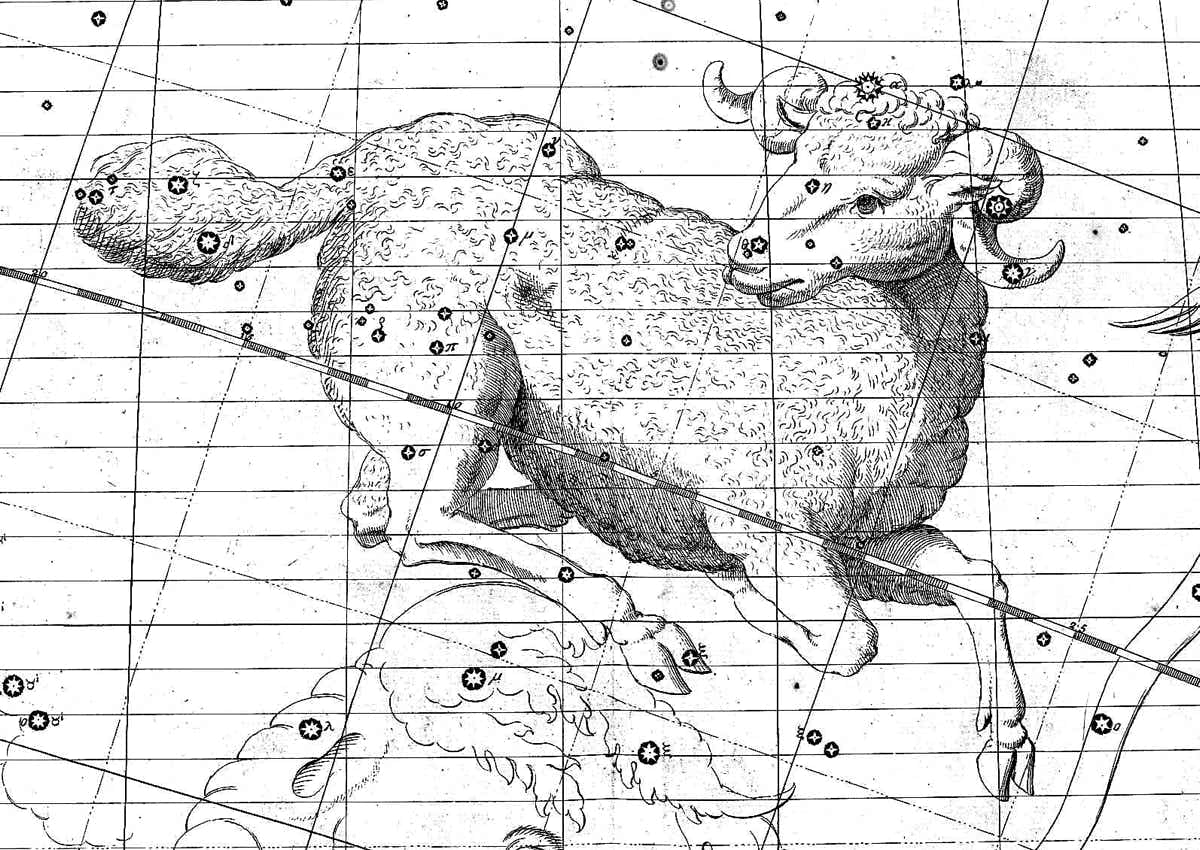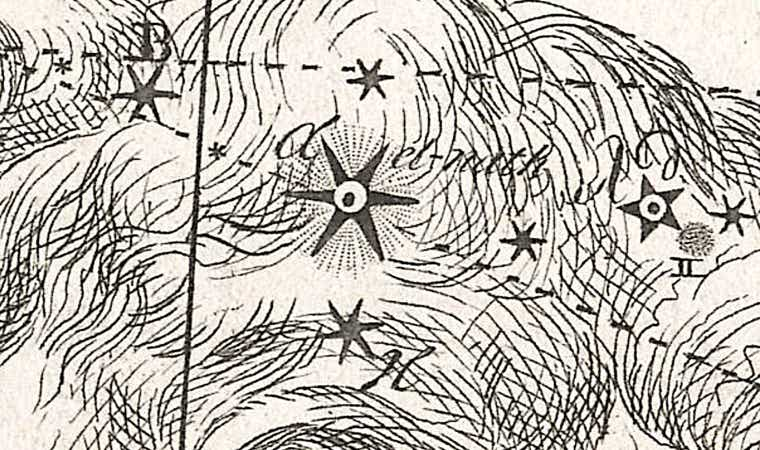
Genitive: Arietis
Abbreviation: Ari
Size ranking: 39th
Origin: One of the 48 Greek constellations listed by Ptolemy in the Almagest
Greek name: Κριός (Krios)
It is not surprising to find a ram in the sky, for rams were frequently sacrificed to the gods, and Zeus was at times identified with a ram. But the mythographers agree that Aries is a special ram, the one whose golden fleece was the object of the voyage of Jason and the Argonauts. This ram made its appearance on Earth just as King Athamas of Boeotia was about to sacrifice his son Phrixus to ward off an impending famine.
King Athamas and his wife Nephele had an unhappy marriage, so Athamas turned instead to Ino, daughter of King Cadmus from neighbouring Thebes. Ino resented her step-children, Phrixus and Helle, and she arranged a plot to have them killed. She began by parching the wheat so that the crops would fail. When Athamas appealed for help to the Delphic Oracle, Ino bribed messengers to bring back a false reply that Phrixus must be sacrificed to save the harvest.
Aries, the ram with the golden fleece, from the Atlas Coelestis of John Flamsteed (1729). In the sky, the ram is without its fleece, which was left behind on Earth.
Reluctantly, Athamas took his son to the top of Mount Laphystium, overlooking his palace at Orchomenus. He was about to sacrifice Phrixus to Zeus when Nephele intervened to save her son, sending down from the sky a winged ram with a golden fleece. Phrixus climbed on the ram’s back and was joined by his sister Helle, who feared for her own life. They flew off eastwards to Colchis, which lay on the eastern shore of the Black Sea, under the Caucasus Mountains (the modern Georgia). On the way Helle’s grip failed and she fell into the channel between Europe and Asia, the Dardanelles, which the Greeks named the Hellespont in her memory. On reaching Colchis, Phrixus sacrificed the ram in gratitude to Zeus. He presented its golden fleece to the fearsome King Aeëtes of Colchis who, in return, gave Phrixus the hand of his daughter Chalciope. Nephele placed the image of the ram among the stars.
Eratosthenes, though, said that the ram was immortal, which would have made sacrificing it highly problematic. Instead, in this version, the ram itself shed its fleece and flew into the sky of its own accord. Either way, the lack of the radiant fleece was said by the mythologists to account for the constellation’s relative faintness.
After Phrixus died his ghost returned to Greece to haunt his cousin Pelias, who had seized the throne of Iolcus in Thessaly. The true successor to the throne was Jason. Pelias promised to give up the throne to Jason if he brought home the golden fleece from Colchis. This was the challenge that led to the epic voyage of Jason and the Argonauts.
When he reached Colchis, Jason first asked King Aeëtes politely for the fleece, which hung on an oak in a sacred wood, guarded by a huge unsleeping serpent. King Aeëtes rejected Jason’s request. Fortunately for the expedition, the king’s daughter, Medea, fell in love with Jason and offered to help him steal the fleece.
At night the two crept into the wood where the golden fleece hung, shining like a cloud lit by the rising Sun. Medea bewitched the serpent so that it slept while Jason snatched the fleece. According to Apollonius Rhodius, the fleece was as large as the hide of a young cow, and when Jason slung it over his shoulder it reached his feet. The ground shone from its glittering golden wool as Jason and Medea escaped with it.
Once free of the pursuing forces of King Aeëtes, Jason and Medea used the fleece to cover their wedding bed. The final resting place of the fleece was in the temple of Zeus at Orchomenus, where Jason hung it on his return to Greece.
Stars of Aries
The Greeks knew the constellation as Κριός (Krios), meaning ram; Aries is the Latin name. On old star maps the ram is shown in a crouching position, but without wings, its head turned back towards Taurus. In the sky it is not at all prominent. Its most noticeable feature is a crooked line of three stars, which marks its head. Of these three stars, Alpha Arietis is called Hamal, from the Arabic for lamb, al-hamal, which was also the Arabic name for the constellation as a whole in their translations of the Almagest. On his chart in Uranographia Johann Bode named this star el-nath, from the Arabic al-nāṭiḥ meaning the butting one, but that name is now restricted to Beta Tauri.
Beta Arietis is Sheratan, from the Arabic al-sharatān meaning ‘two’ of something – possibly two signs or two horns, for it was originally applied to both this star and to its neighbour, Gamma Arietis. Gamma Arietis itself is now known as Mesarthim, a curiously corrupted form of al-sharatān, the title which it originally shared with Beta Arietis.
In the Almagest, Ptolemy described Alpha Arietis as ‘the star over the head’; he adds that Hipparchus had placed it on the ram’s muzzle, although we do not have Hipparchus’s catalogue to confirm this. Oddly, Ptolemy regarded Alpha as lying outside the constellation figure proper and so listed it as one of the so-called amorphotoi, or unformed stars. (On Flamsteed’s Atlas Coelestis, pictured above, it is placed on the top of the ram’s head.) Of its two neighbours, Gamma Arietis was described by Ptolemy as ‘the more advanced of the two stars on the horn’, while Beta Arietis was ‘the rearmost of them’.
Four stars in northern Aries once formed the obsolete constellation Musca Borealis, the northern fly, also known at various times as Apis the bee, Vespa the wasp, and even Lilium the fleur-de-lis, but none of these figures is now recognized by astronomers.
First point of Aries
In astronomy, Aries assumes a far greater importance than its brightness would suggest, for in Greek times it contained the cardinal point known as the vernal equinox. This is the point at which the Sun crosses the celestial equator from north to south. But the vernal equinox is not stationary, because of the slow wobble of the Earth’s axis known as precession.
When the Greek astronomer Hipparchus defined the position of the vernal equinox around 130 BC this point lay south of the star Mesarthim (Gamma Arietis) in the ram’s left horn. The zodiac was then taken to start from here, and so the vernal equinox was commonly known as the first point of Aries. Because of precession, the vernal equinox has moved some 30° since the time of Hipparchus and currently lies in the neighbouring constellation Pisces. By the year 2600 it will have entered Aquarius. Despite this, the vernal equinox is still sometimes called the first point of Aries.
Some early illustrations of Aries depict it with a hoop around its body, such as this example from Hugo Grotius’s Syntagma Arateorum of 1600. This hoop was intended to symbolize the great circle that passes through the celestial poles and the equinoxes, known technically as the equinoctial colure. But because of precession this positioning of the circle was true only for Eudoxus’s time and the hoop was omitted when charts with accurate coordinates were introduced.
Chinese associations
Chinese astronomers knew the crooked line formed by the stars Alpha, Beta, and Gamma Arietis as Lou, usually translated as ‘bond’. Lou was also the name of the 16th lunar mansion. There are various explanations as to what Lou represents, but it appears to be related to the rearing and gathering of cattle for sacrifice. (Alternatively, Ho Peng Yoke translates the name as ‘lasso’, which might well be utilized in the round-up, while Sun and Kistemaker say that Lou was a sickle for harvesting.) At the time the Chinese constellations were established, the full Moon closest to the autumn equinox lay in Lou. According to one story, the Emperor sacrificed a cow or ram just after the equinox, and the lunar mansion Lou was said to be where animals were assembled prior to the sacrifice. The celestial fields where the sacrifice actually took place are represented by Tianyuan in present-day Eridanus.
In the north of present-day Aries is a triangle of 4th- and 5th-magnitude stars (35, 39, and 41 Arietis) that the Chinese called Wei, referring to a fat stomach. The 17th lunar mansion is named after this group. Confusingly, there are two other lunar mansions whose names are also transliterated as Wei, one in Scorpius and the other in Aquarius and Pegasus, although their Chinese characters are different. This Wei in Aries is said to represent granaries for storing cereals.
Five stars in the centre of Aries (probably Nu, Mu, Omicron, Sigma, and Pi) formed Zuogeng, representing a forestry manager. Another five stars farther east, including Delta and Zeta Arietis, formed Tianyin, literally ‘the celestial yin force’, possibly representing the Emperor’s companion on hunting expeditions. To the north of Tianyin was a single star named Tian’e or Tianhe, ‘celestial river’; most likely this was the star we know as HR 999.
© Ian Ridpath. All rights reserved




